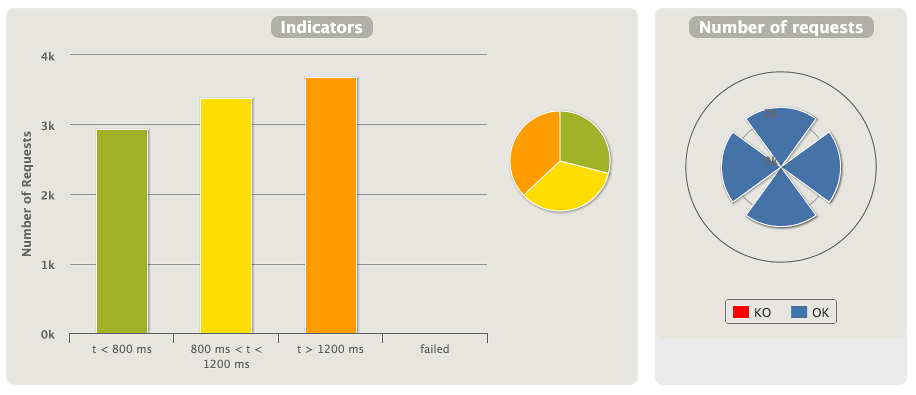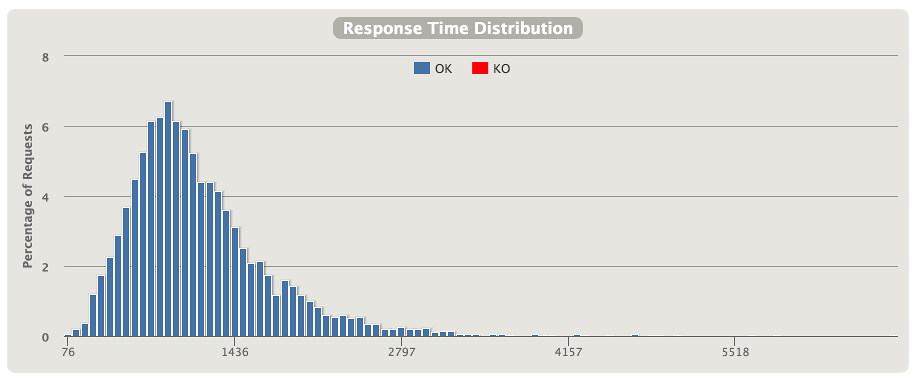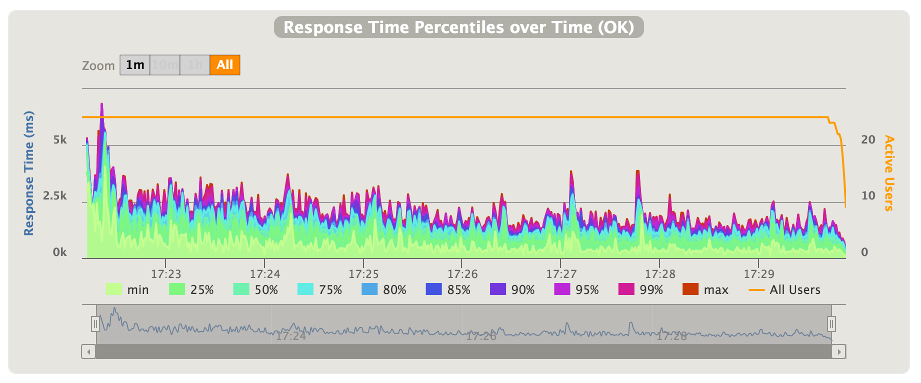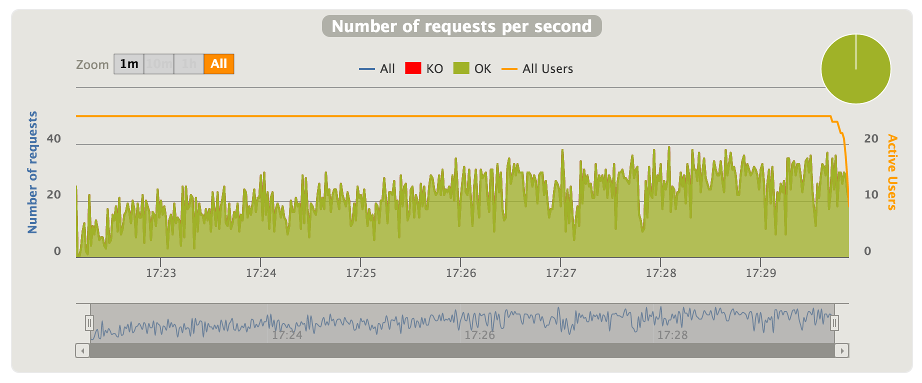Many developers are familiar with the Apache JMeter or Apache Bench tools for writing load tests. Gatling is an alternative tool which provides:
-
a concise Scala DSL in order to Describe a Load Test
-
a simple means to Run a Simulation
-
a nice html Report with all the results
Report
Let’s start by looking at the typical output of a Gatling load test. We have overall distribution of response time for the whole load test:

A more detailed response time distribution:

Response time percentiles over the duration of the test:

And number of requests per second over the duration of the test:

Describe a Load Test
This is how we would write a simple load test which performs 50 GET requests against a server running at test.com:
class SimpleSimulation extends Simulation {
//declare a scenario with a simple get request performed 5 times
val scn = scenario("myScenario")
.exec(http("myRequest").get("http://test.com/page.html"))
.repeat(5)
//run the scenario with 10 concurrent users
setUp(scn.users(10))
}Gatling refers to load tests as Simulations which have one or more Scenarios. In the one above we are saying we will have 10 users execute 5 requests each in parallel. We could provide a Content-Type header with the request and check for a 200 response code like this:
http("myRequest")
.get("http://test.com/page.html")
.header("Content-Type", "text/html")
.check(status.is(200))If we wanted to do a POST request with a JSON body and basic authentication, as well as verify something in the response:
http("myRequest")
.post("http://test.com/someresource"))
.body(StringBody("""{ "myContent": "myValue" }"""))
.asJSON
.basicAuth("username", "password")
.check(jsonPath("$..someField").is("some value"))The expression used to extract someField from the response is passed to jsonPath() and is based on Goessner’s JsonPath syntax. We use is() to verify the expected value is equal to some value. We can also do other forms of verification on the response json like:
-
not(expectedValue): not equal toexpectedValue -
in(sequence): to check that a value belongs to the givensequence -
exists(),notExists(): to check for the presence/absence of a field
For a multipart request with 2 parts and gzip compression:
http("myRequest")
.post("http://test.com/someresource"))
.bodyPart(StringBodyPart("""{ "myContent": "myValue" }"""))
.bodyPart(RawFileBodyPart("file", "test.txt")
.processRequestBody(gzipBody)We can also create scenarios with multiple requests and use the result from previous requests in subsequent requests like this:
scenario("myScenario")
.exec(http("request1")
.post("http://test.com/resource1")
.body(StringBody"""{ "myContent": ""}""")
.check(jsonPath("$..myResponse.guid").saveAs("guid")))
.exec(http("request2")
.put("http://test.com/resource2/${guid}")
.body(StringBody"""{ "someOtherField": ""}"""))guid is extracted from the response of the first call using saveAs("guid") and used in the path to the PUT call.
Scenarios can also be run with a ramp up. If we wanted to run the scenario above with 1000 users with a ramp up of 20 seconds we would do:
setUp(scn.users(1000).ramp(20))Run a Simulation
There are a number of ways to run Gatling simulations. You can download the bundle, place your simulations under the user-files/simulations directory and then run bin/gatling.sh.
If you prefer integration with your build system there are plugins for Maven, Gradle and SBT. For example, for Maven we just add the dependencies in the pom.xml:
<dependencies>
<dependency>
<groupId>io.gatling.highcharts</groupId>
<artifactId>gatling-charts-highcharts</artifactId>
<scope>test</scope>
</dependency>
</dependencies>
<build>
<plugins>
<plugin>
<groupId>io.gatling</groupId>
<artifactId>gatling-maven-plugin</artifactId>
</plugin>
</plugins>
</build>Place simulations under src/test/scala/com/company/service and then in the terminal:
mvn gatling:execute -Dgatling.simulationClass=com.company.service.YourSimulationConclusion
I have found Gatling to be a very effective tool for load testing. The DSL is succinct and the reports generated provide all the information typically needed out of the box.